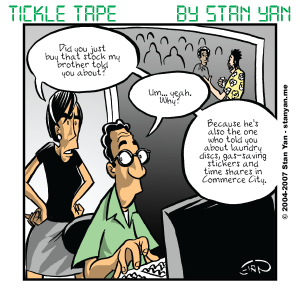Making a profit in the trading world is hardly a sure thing. How you deal with this fact of trading, though, depends on your personality. Some people take risks in stride, while others obsess over them. Which type of person are you, a natural-born risk taker or an obsessive, fearful seeker of safety?
Life is a matter of taking risks, but some people embrace it while others superstitiously try to avoid it. For example, have you ever seen an extremely ineffective car theft device called “The Club?” One is fooled into believing that by putting a massive metal bar on your car steering wheel, you are protected. It seems like it would work until you realize it takes merely a few minutes to cut the steering wheel with a hacksaw and pull it off. Similarly, why do car stereos have removable faceplates?
Do you think thieves are actually unaware that there isn’t an expensive stereo beneath a removed faceplate? These kinds of “protective” devices make us feel better, at least until we realize that they don’t work. At that point, we think, “How could I have been so stupid?” That said, feeling protected helps take the edge off. Even if it is just superstitious behaviour, like wearing your lucky shirt on the day of a big trade, you feel better when you do it. There’s a psychological benefit to it, even if it isn’t foolproof.
We can alleviate some of the uneasiness of taking risks through risk control. By risking a small percentage of your trading capital on a single trade, and looking at the big picture, you will feel more at ease. From a psychological viewpoint, it is to your advantage to make a potential trading loss so insignificant that you may start thinking, “Why am I even bothering making this trade?” There is no universal rule for how to limit risk. Some experts suggest risking merely 2% of your capital, while others suggest 5%, and still, others suggest using past market action to determine the amount of loss you can afford to take (for example, if the market is bullish with many opportunities for profit, then you can take a little more risk.)
The best way to control risk is to set a protective stop, but whether or not you set a stop loss or how you do it depends on your personality and attitude toward risk. If you are a natural-born risk taker, you may not set a formal stop loss at all. You may keep an informal stop-loss point in mind and close your position when the stock price reaches that point. At the other extreme, the obsessive-compulsive, worrier trader may set the stop loss too close to the entry price and end up getting stopped out too early.
The middle ground seems to be reasonable for most traders. Again, it depends on your personality, but if you are afraid to take a loss, a stop loss can help. If you don’t have a stop loss and hate taking a loss, you may not close out a position when the price falls hard. You may be prone to hope against hope that the trade will turn around, and watch your losses mount as you fail to take action. The stop-loss order, however, guarantees that you will be out of the trade should the price take a dive.
The trick is not to be overly rigid or rule-oriented when setting a stop loss. The obsessive-compulsive trader, though, tends to make up superstitious rules for setting a stop loss. For example, suppose that a trader has a $100,000 account and does not want to lose more than 2% or $2,000 on a single trade. Suppose that the trader buys 1000 shares at $50 a share, a potential loss of $50,000. An overly rule-oriented trader may mechanically decide that the price cannot fall below $48 and set a protective stop at that point to restrict the losses to about $2,000. But this is superstitious behaviour to some extent.
The stock may fluctuate between $47 and $51 as rising over time. The trader is likely to be stopped out. It is vital to be more flexible. It may be necessary to purchase less than 1,000 shares and set the stop loss lower in order to minimize risk to about $2,000, or just risk more than $2,000 if the potential profit warrants taking a slightly greater risk. Whatever you do, it’s necessary to accept uncertainty and make a reasonable decision than a superstitious one. Taking losses is difficult, and we all want to seek out protection to ease the burden of making tough decisions, but it’s essential to make reasonable decisions rather than superstitious ones. Protect yourself, but don’t be afraid to take a little extra risk when you need to. Risk is a fact of life, and in order to live productively, you must accept it.


